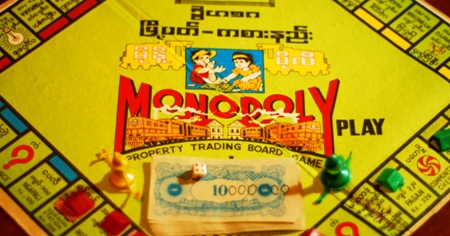
The January 2011 edition of Living Color magazine has a 2010-year-in-review feature that gives a rundown of state assets sold or on sale in Myanmar. Among the items that have already gone out the door are many of the country’s ports, including those at Botataung, Sule, and Bo Aung Kyaw. The Asia World Co. has since started roadwork to link up the Yangon ports and upgrade facilities along the river, as well as to construct a new railway; 182 houses and buildings standing in the way have been demolished.
If you’re too late to snap up a port, then you may find a government building or two still available. Of 110 premises that have gone under the hammer, 35 are or were owned by the Ministry of Industry (1), 21 by each of the ministries of cooperatives and trade, 11 by the Ministry of Information and the remainder by an assortment of others, including the Supreme Court. Perhaps the court’s colonial-era clock tower will soon make way for a glass penthouse view of the independence monument.
Many investors have put their money into petrol stations, of which 246 were up for grabs in 2010. The sales began mid-year, and anyone in Yangon or Mandalay, where about a third of all the stations sold were located, could not help but notice the colourful makeovers of premises as they moved into private hands. Sales took place in all states and divisions, with the largest number of sales outside the two big divisions being in the delta (27 stations) and the lowest number, just one, in Chin State.
If you’ve invested in a petrol station or socialist-period office block and have some cash left over, perhaps you’ll be interested in one of some 6000 condominiums that FMI Co. Ltd. has started constructing on the banks of the Bago River in Thanlyin. The 420-acre project is going to be the largest gated housing project in Myanmar to date, and the company that brought you FMI City in the rather less scenic Hlaingthayar is planning to roll out the new project in phases, beginning with some 900 premises in six towers. Of course, the estate will come with all the facilities you’ll ever need, so going outside will be optional, but if you do choose to leave the round-the-clock private security, you may like to try out the ferry service that will be provided to Pansodan pier.
Once you’ve settled in to your new condo and have had enough of all the buying and selling, perhaps you’ll be ready for a relaxing afternoon at the country’s first artificial beach, the prospects for which Living Color tells us were in 2010 being explored by a team of artificial beach experts from New Zealand, Australia and China, who had linked up with some local gold miners. The intended site for the beach is Myitkyina, which suggests that a key criterion for an artificial beach project is that it be as far away from a real beach as possible. Working on that principle, perhaps once the New Zealanders are done in the north then out of fairness they can also help people in Kawthaung to build an artificial snow-capped mountain.
This is a bumper edition of bumper sales from a bumper year, which in most parts leaves only two questions begging: how much has all this stuff cost, and where’s the money?
 Facebook
Facebook  Twitter
Twitter  Soundcloud
Soundcloud  Youtube
Youtube  Rss
Rss 